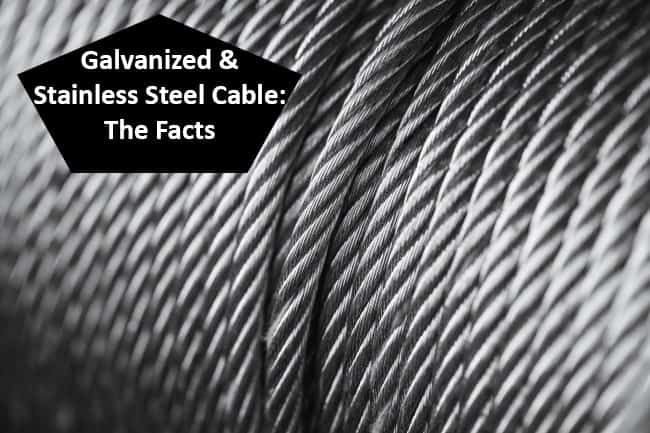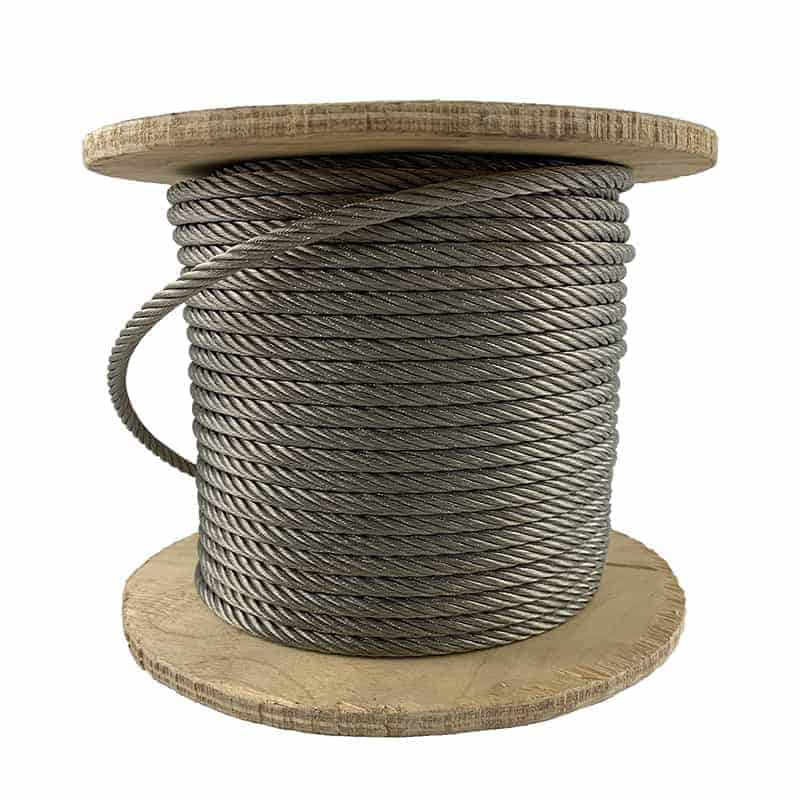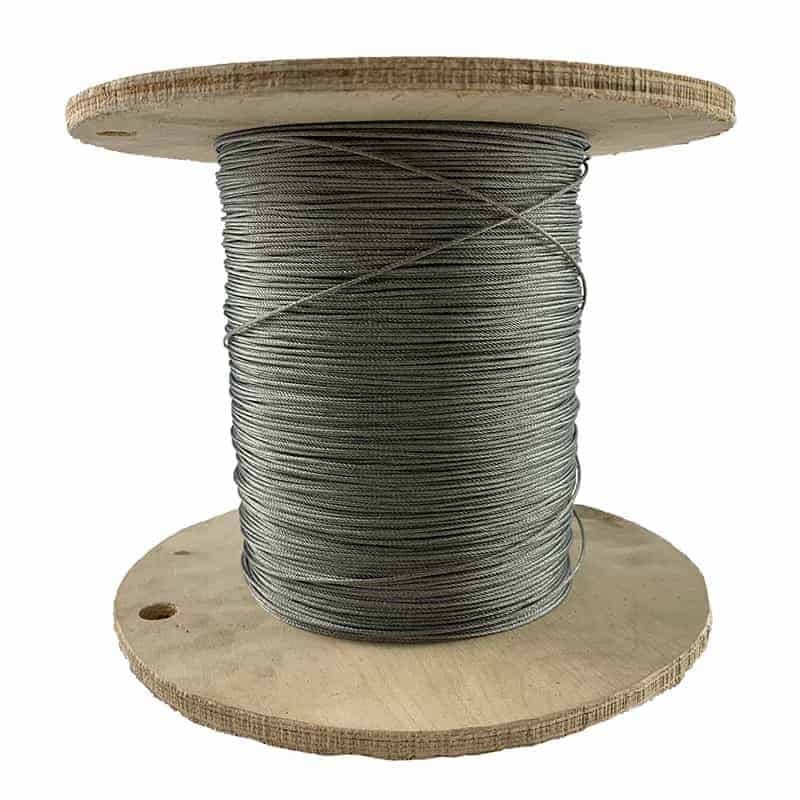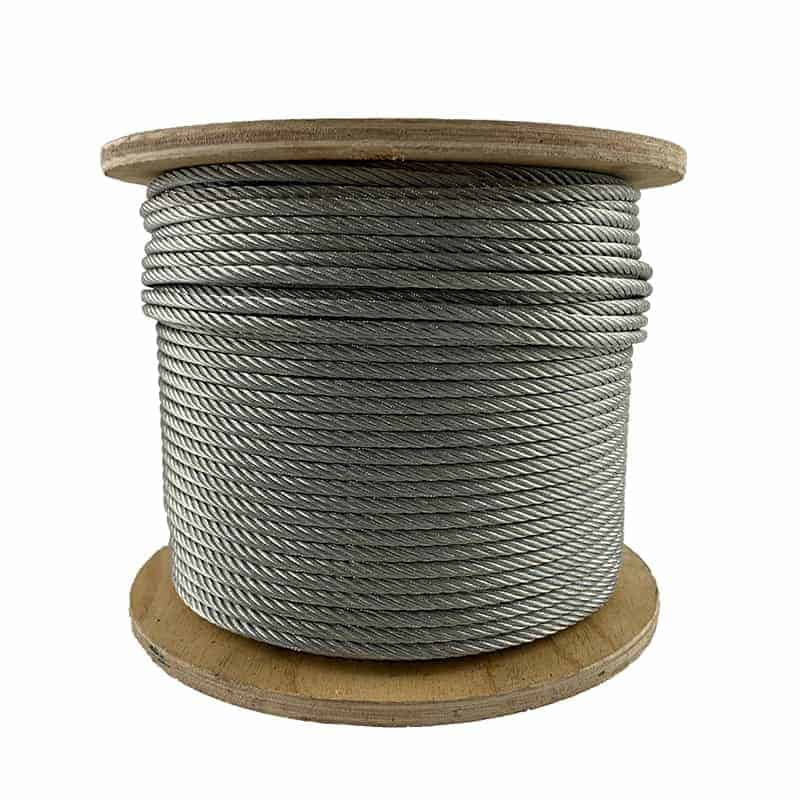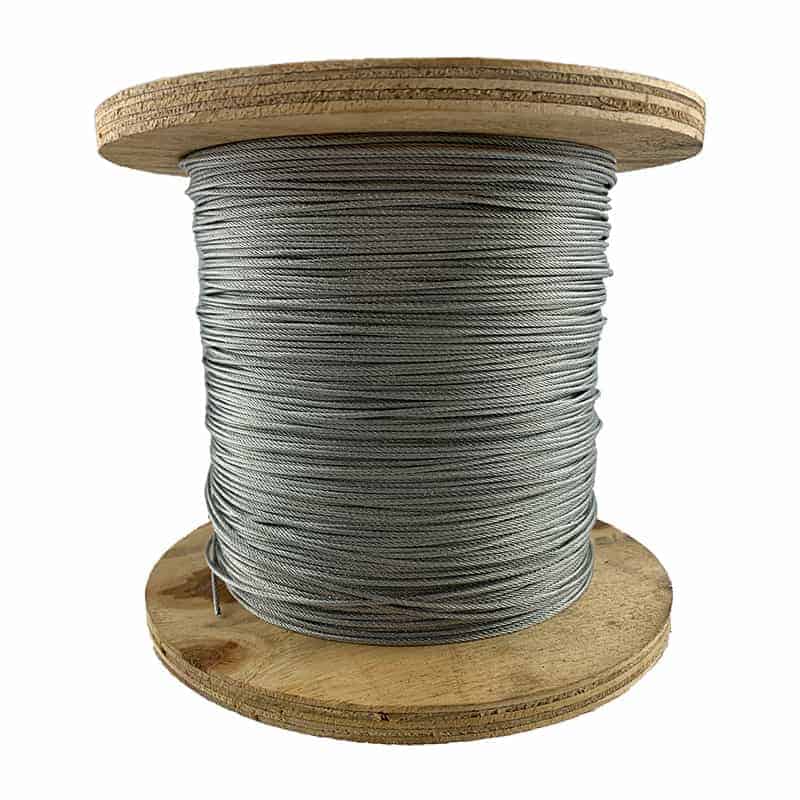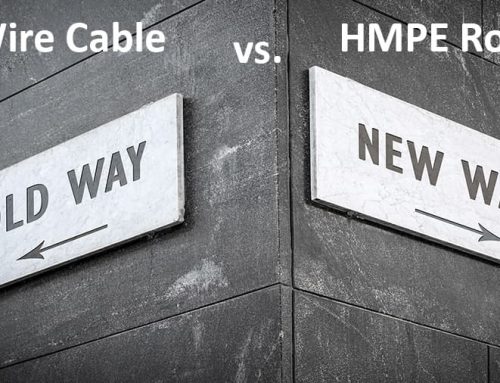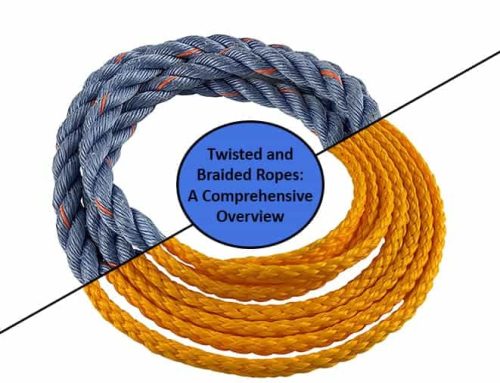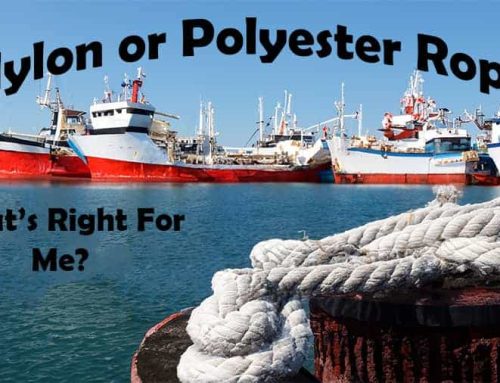Galvanized and Stainless Steel Cable are two popular rigging choices for a wide range of applications, from construction to marine use. There can be a lot of confusion when it comes to the difference in properties they have; corrosion resistance, type 304 vs. type 316, working load limits vs. break strengths, etc. There are similarities between these attributes, however, there are also key differences that are important when it comes to choosing the correct cable for your specific applications.
1. Terminology
“Aircraft Cable” is an outdated term that is still used in the industry today, typically referring to cable sizes up to 3/8″. In the past, these smaller, more flexible cables were used in aircraft controls, hence the name aircraft cable. Newer materials have taken precedence, however, and aircraft cable is NOT used in aircraft today. Still, aircraft cable is widely used in applications where flexibility and strength are important.
“Wire Rope” typically refers to cable that is larger than 3/8″. This makes it stronger and more durable than aircraft cable, but also less flexible. These larger-diameter cables are typically used for hoisting, lifting, and other applications where strength is more important than flexibility.
2. Constructions: The Basics
Galvanized and Stainless Steel Cables are made up of various constructions and diameters to fit many different applications. Steel cable is constructed of strands, which are themselves composed of smaller filler wires – this type of manufacturing gives steel cable its strength and flexibility. The various makeups provide different levels of flexibility and strength; some cables are very stiff and rigid, whereas others are much more malleable. Having these options allows you the opportunity to choose the correct cable to fit your rigging needs.
The most common constructions are 7×7, 7×19, 1×19, and 6×19 IWRC; however, there are many different types of construction in aircraft cable and wire rope.
7×7
A 7×7 cable is a type of wire rope that is made up of 7 strands composed of 7 filler wires. This construction of 7 strands gives the cable some flexibility while also having a great resistance to abrasion. A 7×7 cable works best in static situations when running from one point to another.
7×19
A 7×19 cable is a type of wire rope that is made up of 7 strands composed of 19 filler wires. This construction of 19 filler wires gives the cable greater flexibility when compared to 7×7, but is more susceptible to abrasion because of the smaller wires. A 7×19 cable is used mostly as a working cable on winches and when going through blocks and pulleys.
1×19
A 1×19 cable is a type of wire rope that is made up of 1 strand composed of 19 filler wires. This construction is very stiff and has a high strength-to-weight ratio. It is also very resistant to abrasion and fatigue. This makes it ideal for use in cable rail systems, rigging, and other applications where flexibility is not a major concern.
6×19 IWRC
A 6×19 cable is a type of wire rope that is made up of 6 strands composed of 19 filler wires. The strands are laid around an independent wire rope core (IWRC), which provides additional strength and support. This construction makes the 6×19 IWRC wire rope very strong and resistant to wear and abrasion.
There are many other constructions of wire rope that are used in the construction and rigging industries. These are the 4 most common constructions that are found in general purpose applications.
3. Galvanized Steel Cable: A Protective Coating for Enhanced Durability
Galvanized steel cable is a type of wire rope that has been coated with zinc. The hot-dipped galvanizing process involves immersing regular steel wire rope in a molten bath of zinc at a temperature of approximately 850°C (1562°F). The molten zinc reacts with the iron in the wire rope, forming a protective layer of zinc-iron alloy. This alloy is very resistant to corrosion and rust, and it can help to extend the lifespan of the wire rope.
Galvanized Cable is generally stronger than Stainless Steel, however it does not possess as robust a resistance to corrosion and rust. For outdoor environments where the cable may be subjected to salt-water and harsh weather, stainless steel may be better suited for the job.
Advantages of Galvanized Steel Cable:
-
Cost-Effective Solution: Generally less expensive than stainless steel cable due to the simpler manufacturing process.
-
Suitable for Moderate Corrosion Environments: Provides adequate protection in environments with moderate corrosion risks, such as outdoor applications in mild climates.
-
Aesthetic Appeal: Offers a distinctive silvery appearance, often preferred in certain architectural and design applications.
Drawbacks of Galvanized Steel Cable:
-
Limited Corrosion Resistance in Harsh Environments: Protective zinc coating may deteriorate over time, especially in extreme environments with high humidity, salt exposure, or acidic conditions.
-
Susceptibility to Scratches and Damage: The zinc coating can be scratched or chipped, exposing the underlying steel to corrosion.
Applications of Galvanized Cable:
4. Stainless Steel Cable: Superior Strength and Corrosion Resistance
Stainless steel cable is an alloy of steel that contains at least 10.5% chromium, imparting enhanced corrosion resistance and durability. Chromium is the key element that gives stainless steel its corrosion resistance. When chromium is added to steel, it forms a thin layer of oxide on the surface of the steel. This oxide layer is very stable and protects the underlying steel from corrosion. In addition to chromium, stainless steel may also contain other alloying elements, such as nickel, molybdenum, and manganese. These elements can be added to improve the steel’s strength, ductility, and corrosion resistance.
Stainless Steel cable is generally not as strong as galvanized cable, however it possesses a much greater resistance to rust and corrosion, making it better suited in marine and harsh-weather environments.
Advantages of Stainless Steel Cable:
-
Exceptional Corrosion Resistance: Excels in highly corrosive environments, including marine applications, industrial settings, and areas with extreme weather conditions.
-
Superior Strength and Durability: Offers greater tensile strength and resistance to wear and tear compared to galvanized steel cable.
-
Low Maintenance Requirements: Requires minimal maintenance due to its inherent corrosion resistance.
Drawbacks of Stainless Steel Cable:
-
Higher Cost: Typically more expensive than galvanized steel cable due to the more complex manufacturing process and the use of chromium.
-
Susceptibility to Magnetic Interference: Magnetic, which may pose limitations in certain applications where magnetic fields are present.
Applications of Stainless Steel Cable:
5. Type 304 vs Type 316 Stainless Steel
Type 304 and type 316 stainless steel are two of the most common marine-grade, austenitic stainless steels. They are both known for their excellent corrosion resistance, formability, and weldability.
The main difference between t304 and t316 stainless steel is the addition of molybdenum to t316. This gives t316 stainless steel significantly better corrosion resistance than t304 stainless steel. Molybdenum is particularly effective in protecting stainless steel from chloride ions, which are found in saltwater and other corrosive environments. This also makes type 316 slightly stronger than type 304.
Applications:
304 stainless steel is used in a wide variety of applications, including:
- Kitchen appliances
- Food processing equipment
- Architectural components
- Automotive parts
- Marine hardware
316 stainless steel is used in applications where corrosion resistance is critical, such as:
- Marine fittings and fixtures
- Chemical processing equipment
- Medical implants
- Foodservice equipment
| 304 Stainless Steel | 316 Stainless Steel | |
|---|---|---|
| Chromium content | 18-20% | 16-18% |
| Nickel content | 8-10% | 10-14% |
| Molybdenum content | 0% | 2-3% |
| Corrosion resistance | Good | Excellent |
| Strength | Good | Good |
| Cost | Lower | Higher |
6. Working Load Limit vs. Break Strength
Working Load Limit (WLL) and Break Strength (BS) are two important concepts used to evaluate the capabilities of wire rope. Understanding the distinction between these two terms is crucial for ensuring the safe and effective use of wire rope in various applications.
Working Load Limit (WLL)
The Working Load Limit (WLL) is the maximum safe load that a wire rope can withstand under normal operating conditions. It is a conservative rating that takes into account various factors, generally used at a 5:1 or 4:1 ratio compared to the break strength. The WLL is typically established by industry standards or manufacturer specifications and is expressed in pounds or kilograms. It is important to never exceed the Working Load Limit of a cable, as this can pose safety hazards due to breakage.
Break Strength (BS)
The Break Strength (BS) is the maximum load that a wire rope can theoretically withstand before breaking. It represents the ultimate tensile strength of the wire rope under ideal lab conditions, disregarding any wear, tear, or external factors that could affect its performance. The BS is typically expressed in pounds or kilograms and is higher than the WLL. It is important to never approach the break strength of wire rope as this can impose safety hazards.
The industry standard is using a 5:1 or a 4:1 ratio when it comes to the safe working load limit of a wire rope. For example: 3/32″ 7×19 Galvanized Aircraft Cable has a Break Strength (BS) of 1,000 lbs. This means the safe Working Load Limit (WLL) is 200lbs – 250lbs and should not be exceeding.
7. Choosing the Right Cable for Your Needs
The choice between galvanized and stainless steel cable depends on the specific requirements of the application. If corrosion resistance is a primary concern, stainless steel cable is the better choice. However, if cost is a major factor, galvanized steel cable may be a suitable option.
Key factors to consider:
| Galvanized Steel Cable | Stainless Steel Cable | |
|---|---|---|
| Corrosion Resistance | Good | Excellent |
| Strength | High | Moderate |
| Cost | Less expensive | More expensive |
| Applications | Fencing, railings, overhead power lines | Marine applications, architecture and design, industrial applications |
8. Conclusion
Galvanized and stainless steel cable both offer unique advantages and disadvantages. By understanding the key differences between these two types of cable, you can make an informed decision based on the specific requirements of your application. Consider factors such as corrosion resistance, strength, cost, and intended use to determine which type of cable is best suited for your needs.

